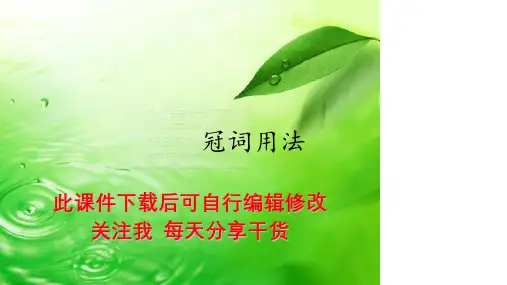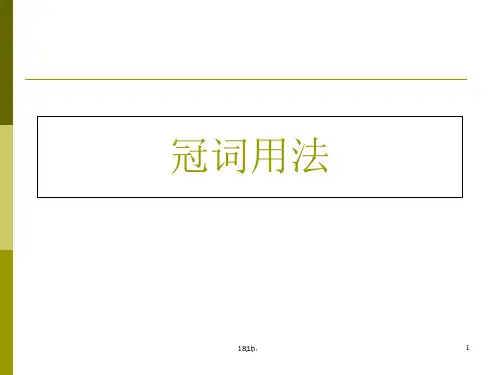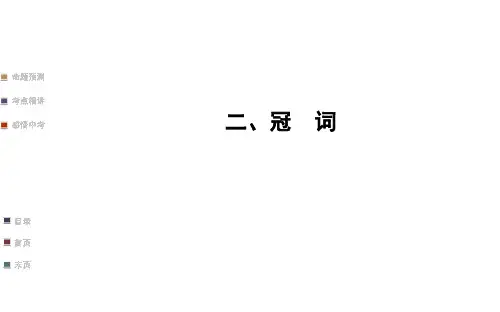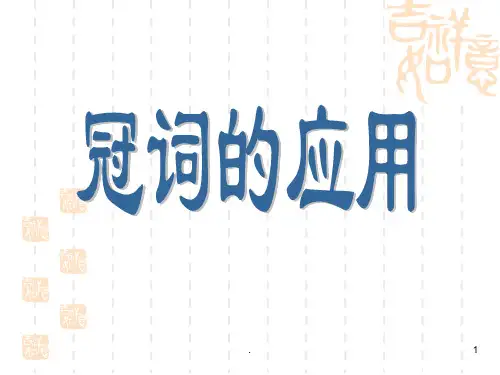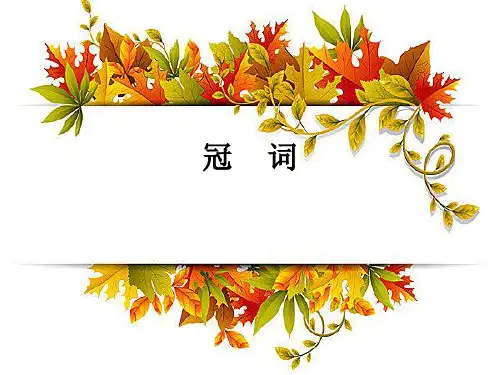- 1、下载文档前请自行甄别文档内容的完整性,平台不提供额外的编辑、内容补充、找答案等附加服务。
- 2、"仅部分预览"的文档,不可在线预览部分如存在完整性等问题,可反馈申请退款(可完整预览的文档不适用该条件!)。
- 3、如文档侵犯您的权益,请联系客服反馈,我们会尽快为您处理(人工客服工作时间:9:00-18:30)。
2020/12/104 Nhomakorabea / an的用法
7. 用在序数词前面表示“再一次,又一次”。
Ten years after the death of her husband, she got married for a second time.在她丈夫去世十年后, 她再次结婚了。 8. 用在many, quite, rather, such, twice, what 等词后 面,构成短语。 It’s quite a problem. 这是一个相当难的问题。
是在1990年。 Could you tell me the shortest way to the station?你 能告诉我去火车站最近的路吗?
2020/12/10
9
the的用法
10. 和表示数量的名词连用,表示“以...为单位”
• Eggs are sold by the dozen. 鸡蛋按打来卖。
• an honest man (hour, honor, a, e, h, i, l, m, n, o, r, s, x…)
• an 80-metre-high-tower
2020/12/10
6
the的用法
1. 基本用法:有明确的所指;可以与任何名词连 用
Shut the door. 关门。 Where will the meeting be held? 在哪儿开会? 2. The + adj.表示一类人或事物
5. 用在乐器之前 My sister is learning the flute/ piano.我妹妹在学笛子/
钢琴。
6. 用在逢十的复数数词之前,指世纪中几十年代 in the 1870’s 十九世纪七十年代 , 7. 用在姓氏的复数形式前,表示这一家人。
the Smiths史密斯一家人
2020/12/10
I’ve never seen such an exciting football match before. 我以前从来没见过这么精彩的比赛。
2020/12/10
5
a / an的用法
9. 注意区分a/an:一般来说,an用在元音前, a用在非元音前。但注意下面的特殊例子。
• a Europe (European, one-way street, union, university, useful tool, usual way…)
• He is paid by the hour / the day/ week/ month.他按小 时/天/周/月来付酬。
11. 与名词连用时,要注意与不定冠词的区别。
a / the most interesting…非常有趣的… / 最有趣 的…
a / the number of
许多 / …的数量
2. 第一次提到某物 I looked up and saw a plane. 我抬头看见了一架飞机.
3. 用在称呼前,含有“我不认识...的感觉” A Mr. Smith is waiting to see you.一位史密斯先生正等
着要见您。
2020/12/10
3
a / an的用法
4. 可以表示量度单位,"每..." 40 km an/per hour 每小时40公里 twice a/per day 每天两次
很厚。
2. 用在泛指的一日三餐前 • Have you had breakfast/ lunch/ dinner? 你 吃 早 饭 /
午饭/晚饭了吗? • 比较:The breakfast was well cooked. 这顿早饭做得
好。
2020/12/10
11
零冠词
3. 用在球类,棋类之前 • Let’s go and play football.我们去踢足球吧。 • How about having a game of chess, John? 约翰,
8
the的用法
8. 用在某些习惯表达法中的介词短语中,指有关者 的身体或衣着的一部分
• lead sb. by the hand拉着某人的手, • hit sb. in the face打在某人的脸上, • grasp sb. by the sleeve抓住某人的袖子 9. 用在形容词最高级和序数词前面。 • The first time I saw him was in 1990.我第一次见他
for a/ the moment
片刻,一会儿/ 暂时,目前
give sb. a / the push 推某人一下 / 解雇某人
2020/12/10
10
零冠词
1. 表示泛指或一般概念 • Snow is white. 雪是白的。 • 比较:The snow in the yard is very thick.院子里的雪
the British英国人, the rich富人, the young年 轻人, 3. 表示一天的各段时间
in the morning/ afternoon/ evening
2020/12/10
7
the的用法
4. 表示独一无二的自然现象,方位,左右 the earth地球, the sun太阳, the east东, the west西, the right右, the left左
咱们下盘棋好吗? 4. 用在称呼语及表示家庭成员(常大写)的名词
之前
• Tom asked, “Where’s Father/ Mother/ Aunt?” 汤姆问,“爸爸/妈妈/姑姑在哪儿?”
5. 与可数名词连用位于what, such之后,表示感叹, 或强调程度
What a surprise! 真是让人吃惊。 My boss is such a fool! 我的老板这么蠢。 6. 用在形容词最高级前,相当于very。 This is a most useful dictionary.这是一本非常有 用的字典。
冠词的用法 (Articles)
2020/12/10
1
I. 分类 不定冠词a/an, 定冠词 the, 零冠词(不用冠词)
2020/12/10
2
a / an的用法
1. 表示“某种类别当中的一个”,“该类中的一例” A cat is an animal.猫是一种动物。 He’s a Frenchman.他是个法国人。
